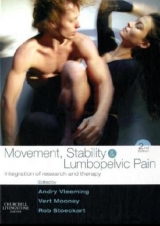
Movement, Stability and Low Back Pain
Churchill Livingstone (Verlag)
978-0-443-05574-4 (ISBN)
- Titel erscheint in neuer Auflage
- Artikel merken
The human pelvis has recently become a focus for a considerable amount of new research which is relevant to manual therapy practice. In particular, movement within the pelvis is now being recognised and studied in relation to its role in maintaining stability in the vertebral column and subsequent implications for the prevention and treatment of low back pain. This important new subject area for clinicians is now covered in depth in this groundbreaking book from the people at the forefront of research and practice in the field. The contributors represent the breadth of professionals involved in manual therapy, from osteopathy, chiropractic and manual physical therapy, to orthopaedic medicine and surgery, anaesthesia and pain control. The text presents the latest research and developments in this high profile and fast developing area and demonstrates the relevance of the research to clinical practice.
Founder, Spine and Joint Center, Rotterdam, Netherlands
PART 1 BASIC RESEARCH SECTION 1 ANATOMY and PATHOPHYSIOLOGY: the Muscular, Ligamentous and Neural Structure of the Low Back and Its Relation to Pain. Sacroiliac Joint Dysfunction. The Role of the Sacroiliac Joints in Coupling Between Spine, Pelvis, Legs, And Arms. The Role of the Sacroiliac Joints in Low Back Pain: Basic Aspects, Pathophysiology and Management SECTION 2 BIOMECHANICS: Biomechanics of the Human Pelvic Bone. Biomechanics of the Interface Between Spine and Pelvis in Different Postures. Coupled Motion of Contralateral Latissimus Dorsiand Gluteus Maximus: Its Role in Sacroiliac Stabilization. Kinematic Models and the Human Pelvis. Suboptimal Posture: The Origin of the Majority of Idiopathic Pain of the Musculoskeletal System. A Different Approach to the Mechanics of the Human Pelvis: Tensegrity SECTION 3 MOBILITY of the SACROILIAC JOINTS: Movement of the Sacroiliac Joint: A Fresh Look. The Mobility of Sacroiliac Joints in Healthy Subjects. Interinnominate Range of Motion SECTION 4 the LUMBOPELVIC RHYTHM: the Combined Function of Spine, Pelvis and Legs When Lifting with a Straight Back . The Role of the Hamstrings in Pelvic and Spinal Function SECTION 5 EVOLUTION and GAIT: Evolutionary Aspects of the Human Lumbosacral Spine and Their Bearing on the Functionof the Lumbar Intervertebral and Sacroiliac Joints. Elasticity in Human and Animal Backs. Instability of the Sacroiliac Joint and the Consequences for Gait. Clinical Aspects of the Sacroiliac Joint in Walking. Linking the Spinal Engine with the Legs: A Theory of Human Gait. Lower Back Pain as a Gait-Related Repetitive Motion Injury PART 2 CLINICAL ASPECTS SECTION 6 DIFFERENTIAL DIAGNOSIS: Sacroiliac Joint Injection: Pain Referral Mapping and Arthographic Findings. Pain Provocation Sacroiliac Joint Tests: Reliability and Prevalence. Measurement of Sacroiliac Joint Stiffness with Color Doppler Imaging and the Importance of Asymmetric Stiffness in Sacroiliac Pathology. Psoas Dys Function/Insufficiency, Sacroiliac Dysfunction and Low Back Pain. Differential Diagnosis of Lumbar Back and Pelvic Pain SECTION 7 VISUALIZATION: Basic Problems in Visualization of the Sacroiliac Joint. CT and MRI of the Sacroiliac Joints. Visualization of Pelvic Biomechanical Dysfunction. Lateral Dynamic X-Rays in the Sitting Position and Coccygeal Discography in Common Coccydynia SECTION 8 PREGNANCY and PERIPARTUM PELVIC PAIN: Quadrupedalism, Bipedalism and Human Pregnancy. Epidemiology of Pelvic Pain and Low Back Pain in Pregnant Women. Lumbar Back and Posterior Pain in Pregnancy. S-Relaxin and Pelvic Pain in Pregnant Women. Active Straight Leg Raising Test: A Clinical Approach to the Load Transfer Functionof the Pelvic Girdle SECTION 9 THERAPY: Behavioral Analysis, Fear of Movement/(Re) Injury and Behavioural Rehabilitation in Chronic Low Back Pain. Treatment of Pelvic Instability. Mechanics and Treatment of the Sacroiliac Joint. Treatment of Gravitational Strain Pathophysiology. Pelvic Mechanics and Prolotherapy . Assessment and Treatment of Sacroiliac Joint Dysfunction Utilizing Isolated Resistance Training and Manual Mobilization in a Chronic Worker's Compensation Population. Evaluationand Treatment of the Most Common Patterns of Sacroiliac Joint Dysfunction. Deep-Seated Low Back Pain - A Triad of Symptoms for Pelvic Instability SECTION 10 SURGERY: Surgical Fusion of the Spine to the Sacrum. Surgical Treatment of Chronic Painful Sacroiliac Joint Dysfunction. Sacroiliac Joint Anthrodesis in Selected Patients with Low Back Pain. Percutaneous Fixation of the Sacroiliac Joint
| Erscheint lt. Verlag | 9.7.1997 |
|---|---|
| Zusatzinfo | 600 ills. |
| Verlagsort | London |
| Sprache | englisch |
| Maße | 191 x 248 mm |
| Gewicht | 1535 g |
| Themenwelt | Medizin / Pharmazie ► Medizinische Fachgebiete ► Chirurgie |
| Medizin / Pharmazie ► Medizinische Fachgebiete ► Sportmedizin | |
| Studium ► 1. Studienabschnitt (Vorklinik) ► Anatomie / Neuroanatomie | |
| Studium ► 1. Studienabschnitt (Vorklinik) ► Physiologie | |
| ISBN-10 | 0-443-05574-2 / 0443055742 |
| ISBN-13 | 978-0-443-05574-4 / 9780443055744 |
| Zustand | Neuware |
| Haben Sie eine Frage zum Produkt? |
aus dem Bereich



